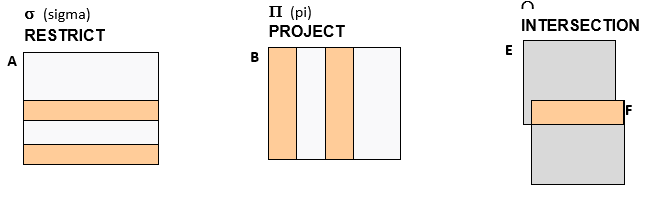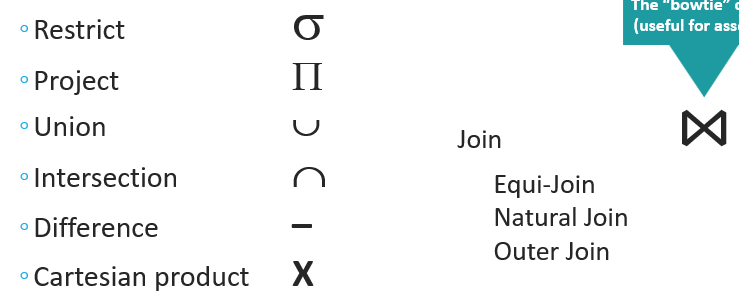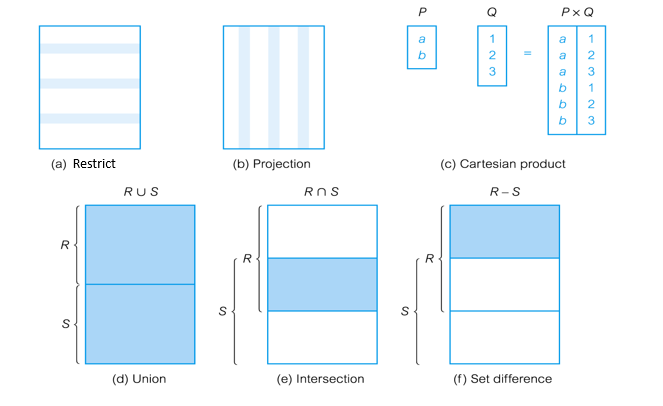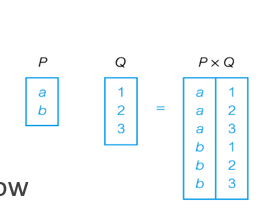Relational model
1/66
There's no tags or description
Looks like no tags are added yet.
Name | Mastery | Learn | Test | Matching | Spaced |
|---|
No study sessions yet.
67 Terms
definition: relational model
a relational db is a collection of related tables
purposes of a function
Maps sets of inputs to sets of outputs.
Associates an input value with a specific output value.
Ensures each input is related to exactly one output.
what is a relation/table
Represents data logically.
Physically implemented as a table.
Enables precise explanation of database operations.
types of relational model
logical
formal
data
logical model
independent of physical implementation
formal model
uses set theory and predicate logic
data model
Concepts used to describe the database, i.e., the contain information
Simple but powerful; still the foundation for databases
three aspects of data
data structure
data integrity
data manipulation
data structure
table, column, domain, row
entities and their relations
data integrity
null, entity Integrity, referential integrity, general constraints
(rules that ensure the data is accurate, consistent and valid)
data manipulation
relational algebra
(using relational algebra to retrieve, edit and add data to our database)
what does a relational model consist of
data structure
data constraints
relational operators
data constraints
Restrictions on data, relations, …
relational operators
Restrict, project, cartesian product, union, difference, …
What are the objectives of a relational model in databases?
Achieve high data independence (allow changes without affecting applications).
Control redundancy (data not stored in multiple locations).
Maintain consistency (copies are accurate and up-to-date).
Enable set-oriented manipulation languages (e.g., relational algebra).
row
records or tuple
Represents an individual instance of an entity.
Uniquely identified by one or more attributes (primary key).
Primary key must not contain null values (entity integrity rule).
column
field or attribute
Each column heading in a table has a distinct name
Its value must be atomic, i.e. a single value drawn from the domain of the column
table
relation
has rows and columns
represents a kind of entity or class
each table is has a unique name for id
Key properties:
No duplicate rows.
Row/column order doesn't matter.
Columns have unique names.
What is a domain in databases?
A domain is the set of possible values that a column can take.
How are columns in a table defined in relation to domains?
Every column in a table is defined on a domain.
Why are domains unrelated in databases?
Unrelated domains restrict column comparisons and prevent meaningless operations.
Can multiple columns share the same domain?
Yes, columns like SID and CID may have the same domain.
Can domains be infinite?
Domains may be potentially infinite but are constrained in the real world.
Key
one or more columns that determine (imply) other columns
Or: one or more columns to uniquely identify a row
types of keys:
candidate
primary
alternate
foreign
composite
candidate key
A minimal set of columns which uniquely identifies each row
alternate key
The remaining candidate keys after one is chosen as the primary key.
Alternate keys are potential unique identifiers for table rows.
primary key
The chosen candidate key to uniquely identify each row
foreign key
Columns (or a set of columns) that matches the candidate key of the associated table
Used to represent relationship between tables
composite key
Refers to a key consisting of two or more columns
null values
A NULL value is required to deal with missing information: value unknown, inserted later..
not the same as “ “ (blank) or 0
db constraints
Integrity constraints ensure the database doesn't have invalid values or configurations.
They ensure the data is accurate and reliable.
What are the types of database constraints?
Application/DB-Specific Constraints: Align with enterprise or business rules.
Integrity Constraints:
Entity Integrity: Each row is unique and identifiable.
Referential Integrity: Ensures accuracy and consistency between tables.
Multiplicity Constraints:
Required Data: Primary key cannot be null
Domain Constraints: Enforces valid values for a column.
integrity constraints
Entity integrity rule:
constraint on primary keys
Value of a primary key must be unique and
not null
Referential integrity rule:
constraint on foreign keys
Value of a foreign key must either match the candidate key it refers to
or be null
what does a relational model comprise of
structural definition
integrity rules
data manipulation
main languages used to deal with data manipulation
relational algebra
relational calculus
What is relational algebra in databases?
Theoretical language for manipulating relations
Provides operations to define new tables without modifying original ones.
Forms the basis for SQL query execution.
Supports nesting expressions and closure.
Operands and results are tables, enabling chaining of operations.
visual summary of operations

natural join

restrict operation
defines horizontal subset table
called a unary operator as it works on a single tables
project operation ⫪
defines vertical partitioning of a table
intersection operation
set intersection on tables:
only rows contained in both
natural join operation ⋈
cartesian product, removing common duplicated columns
relational algebra is a procedural language
query is evaluated in the order specified
complex queries are evaluated by:
Nesting operations to create a relational expression
or applying operations one at a time and creating temporary tables
processing complex queries
most efficient one is preferable
relational algebra Vs Relational calculus - similarities
they are formal, theoretical - based on maths principals, non user friendly
used as a basis for data manipulation
lang for relational db
used to define operations to manipulate tables
equivalent in terms of expressive power
relation algebra Vs relational calculus - differences
relational algebra - is procedural , specifies how to achieve
relational calc - is declarative , specifies what to achieve
closure
property where operations produce only tables based on elements of the input tables
relational algebra operations 5+2
5 basic operations:
restrict (unary)
projection(unary)
cartesian product
union
set difference
2 operations expressed in terms of basic operations:
join
intresections
relational algebra symbols

visual interpretation summary

comparison operators
<, >, <=, >=, =, ≠
boolean operators
∧ - and ∨- or ∾- not
set operations
∪ = union
∩= intersection
- = difference
∪ union
combines two tables
removes all duplicate rows
∩ intersection
returns rows that appear in both tables
- = difference
returns rows that are in on and not the other table
T ← R - S
output all the rows that are in R but not in S
cartesian product (X)
multiplies two tables
PQ ← P x Q

types of join operations
equi-join
natrual join
outer join : left outer join, right outer join, full outer join
join ⋈
combines 2 tables to form a new one
derivative of the cartesian product where all elements satisfy p
col involves in ajoin condition p must have the same domain
equi - join
condition of equi- join contains only equality comparisons
outer join
used when displaying rows in the result that don’t have matching values in the join col
avoids info loss and includes unmatched rows in the result table
problems with natural join
rows not included when:
join cols are null or dont have matching rows in another tables
can cause loss of data
left outer join
includes all rows from R1 even unmatched ones
missing values of rows from R2 are set to null
right outer join
includes all rows from R2 even the unmatched ones
missing values of froms from R1 are set to null
full outer join
inludes all rows from R1 and R2, even unmatched ones
missing val set to null